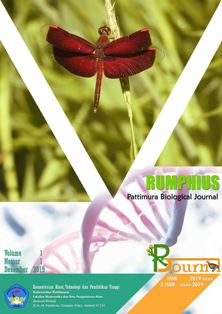NUTRITION OF LUMUT BANANA (Musa Acuminate Colla) AMBON PEEL AT SEVERAL LEVEL OF FRUIT MATURITY
Abstract
Banana peel is a waste from processed ripe bananas such as making various types of cakes from banana flesh, while unripe banana peels are waste from unripe bananas whose flesh is made into chips and contains a lot of latex when compared to ripe and overripe banana peels. This may affect the nutritional content in the two banana peels, because the maturity level of the banana peel affects the nutrient content in the peel. Based on this, this research needs to be carried out with the aim of knowing the nutritional content of raw, ripe and overripe Ambon Moss banana peels (Musa accuminata colla) in Ambon City, Maluku Province. The method used in this study is descriptive quantitative, namely to determine the analysis of the nutritional value of carbohydrates, protein, fat, and calcium in raw and ripe Ambon Moss Banana (Musa accuminata colla) peels in Ambon City, Maluku Province. The results that have been obtained are that the raw Ambon banana peel has an average carbohydrate content of 4.02%, a fat content of 0.85% and a protein content of 0.31%. Ripe Ambon banana skin has an average carbohydrate content of 4.11%, fat content of 1.19% and protein content of 0.31%. Meanwhile, in the overripe Ambon banana peel, the average carbohydrate content was 3.96%, the fat content was 1.68% and the protein content was 0.64%.
Downloads
References
Astawan. 2008. Making Noodles and Vermicelli. Self-Help Spreader. Jakarta.
AOAC, Official Methods of Analysis of AOAC International. Ed. 8th. Maryland: AOAC International. 1999
Caussiol, L. 2001. Postharvest quality conventional and organically grown Banana fruit. Master of science by Research in Postharvest Technology. Institute of Agriculture of Agritechnology. Cranfield University. Silsoe.
Gunawan, T. 2013. Contents and Benefits of Banana Peel. http://tanamanobatherbal.blogspot.com/2013/02/kandungan-dan-besar-kulit-pisang.html.
International Starch Institute. 2002. Danish International Standard: ISO 5377ISI 28-1e Determination of Reducing Sugar, DE by Luff-Schoorl's method. Science Park Aarhus, Copenhagen.
Johari and Rahmawati. 2006. High School Chemistry for Class XII. Esis. Jakarta.
Kaleka, N. 2013. Commercial Bananas. Solo: Arcita.
Kumalaningsih, S. 1993. Modern Fresh Banana Handling and Processing System. Malang: Tribhuwana Agricultural College.
Koni, Theresia, N.I. 2013. Journal of the Utilization of Fermented Banana Peels from Rhyzopus oligosporus in Feeds on the Growth of Broiler Chickens. Kupang: Faculty of Animal Husbandry, Nusa Cendana University. Vol.14 No.3:365-370.
Maluku in Numbers. 2009. Central Bureau of Statistics. Jakarta.
Mahmudah, N. A. Bambang S. A, E. Widowati. 2017. Physical, Chemical and Sensory Characteristics of Samarinda Kepok Banana Flakes (Musa Paradisiaca Balbisiana) with Garut Starch Substitution. Journal of Agricultural Products Technology. Sebelas Maret University Surakarta Vol. X, No. 1: 32-40.
Mahardikasari, L.W. 2010 . Acute Toxicity Test of Ambon Banana Stem Extract (Musa paradisiaca var sapientum) Against Mice (Mus musculus) Liver with LD50 parameter. Airlangga University. Surabaya.
Munadjim. 1998. Banana Processing Technology. Publisher PT Gramedia, Jakarta.
Morris, W.L., L. Ducreux, D.W. Grifths, D. Stewart, H.V. Davies, and M.A. Taylor. 2004. Carotenogenesis during tuber development and storage in potato. Journal of Experimental Botany 399: 975-982. DOI: 10.1093/jxb/erh121.
Pradhana, A.Y., R. Hasbullah, Y.A. 2013. Purwanto. Effect of adding potassium permanganate on the quality of bananas (cv. Mas Kirana) in active modified atmosphere packaging. Indonesian Postharvest Journal. 10(2): 83-94.
Purba, F.H.K. 2004. Banana Production in Indonesia. Sub-Directorate for Promotion and Market Development, Directorate of International Marketing, DITJEN PPHP.
Roiyana, M. Izzati, and E. 2013. Prihastanti. "Potential and Efficiency of Vegetable Hydrocolloid Compounds as Fruit Ripening Delaying Agents," Dh Sellula Anatomy and Physiology Bulletin, vol. 20, no. 2, pp. 4050, Apr.
Santoso, A. Dietary Fiber and its Health Benefits. Magistrate No. 75 Yr. XXIII. 2011
Susanti, L. 2006. Differences in the Use of Banana Peel Types on Nata Quality. (Thesis), Semarang State University.
Sumadi., B. Sugiharto, and Suyanto. 2004. Sucrose Metabolism in the Ripening Process of Banana Fruit Treated With Different Temperatures. Journal of Basic Sciences. Faculty of Agriculture. Jember University.Vol. 5(1): 21-26.
Supriyadi, Ahmad and Suyanti Satuhu. 2008. Bananas, Cultivation, Processing and Market Prospects. Jakarta: Self-Help Spreader.
Sudarmadji, S. B. Haryono, and Suhardi. 1989. Analysis of Food and Agricultural Ingredients. Liberty. Yogyakarta.
Tarrakoon, T. , N. Chalermsan., T. Vearasilp and U.T. Meulen. 1999. The Nutritive Value of Banana Pee l (Musa sapieutum L) in Growing Pigs. Sustainable Technolgy Development in animal Agriculture, Berlin.
Wijaya. 2013. Benefits of Native Indonesian Fruit. PT Gramedia. Jakarta.
Winarno, F.G. 2004. Food Chemistry and Nutrition. Scholastic. Jakarta.
Authors who propose a manuscript and have it approved for publication know that the manuscript will be registered and become part of the RPBJ. Authors and readers understand that this journal is open and all its contents can be accessed freely, provided that RPBJ is still listed as the source of information. The hope is that this journal can become a vehicle for exchange and scientific knowledge for society and the scientific community, especially in the field of Biology and other branches of science.









